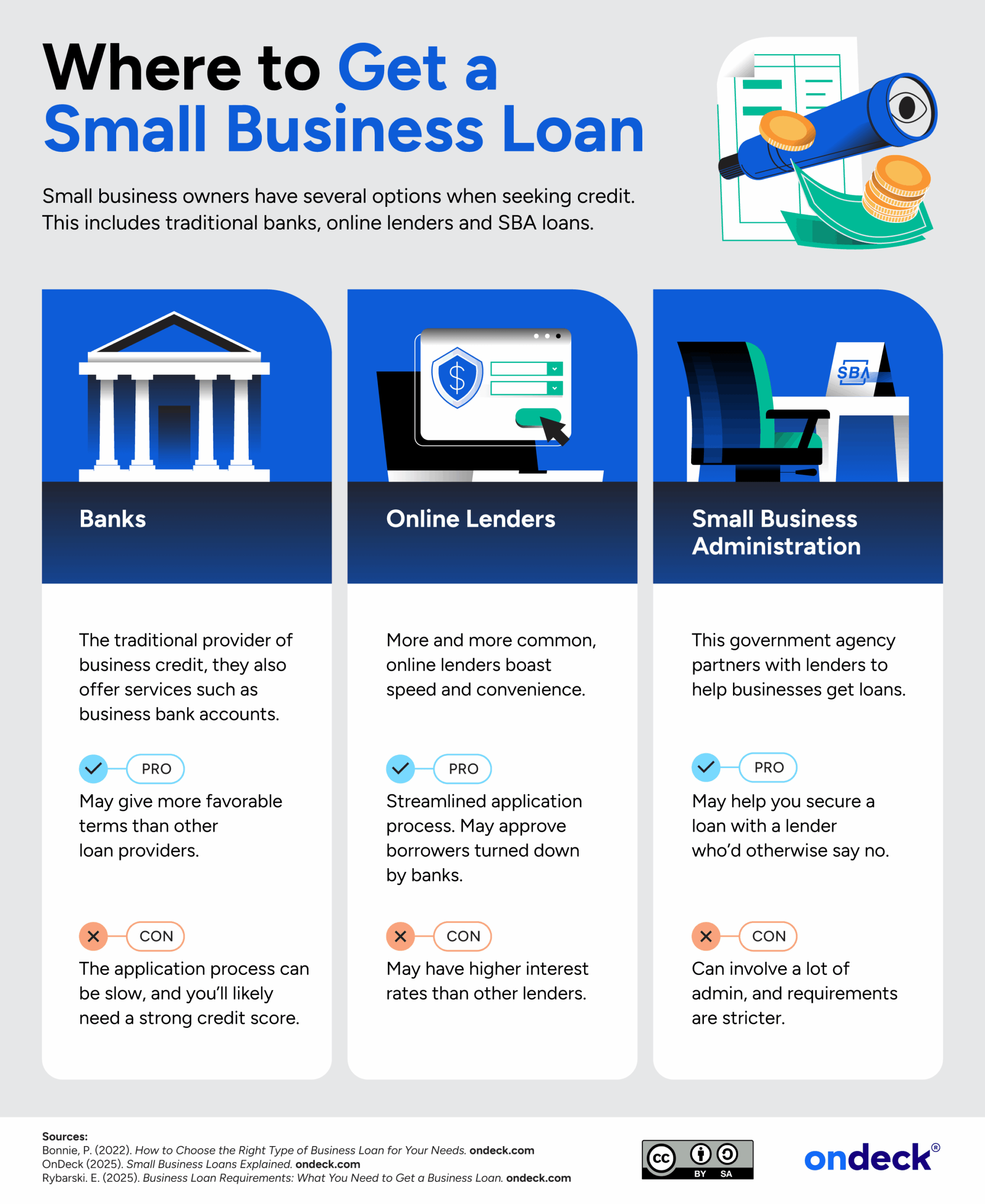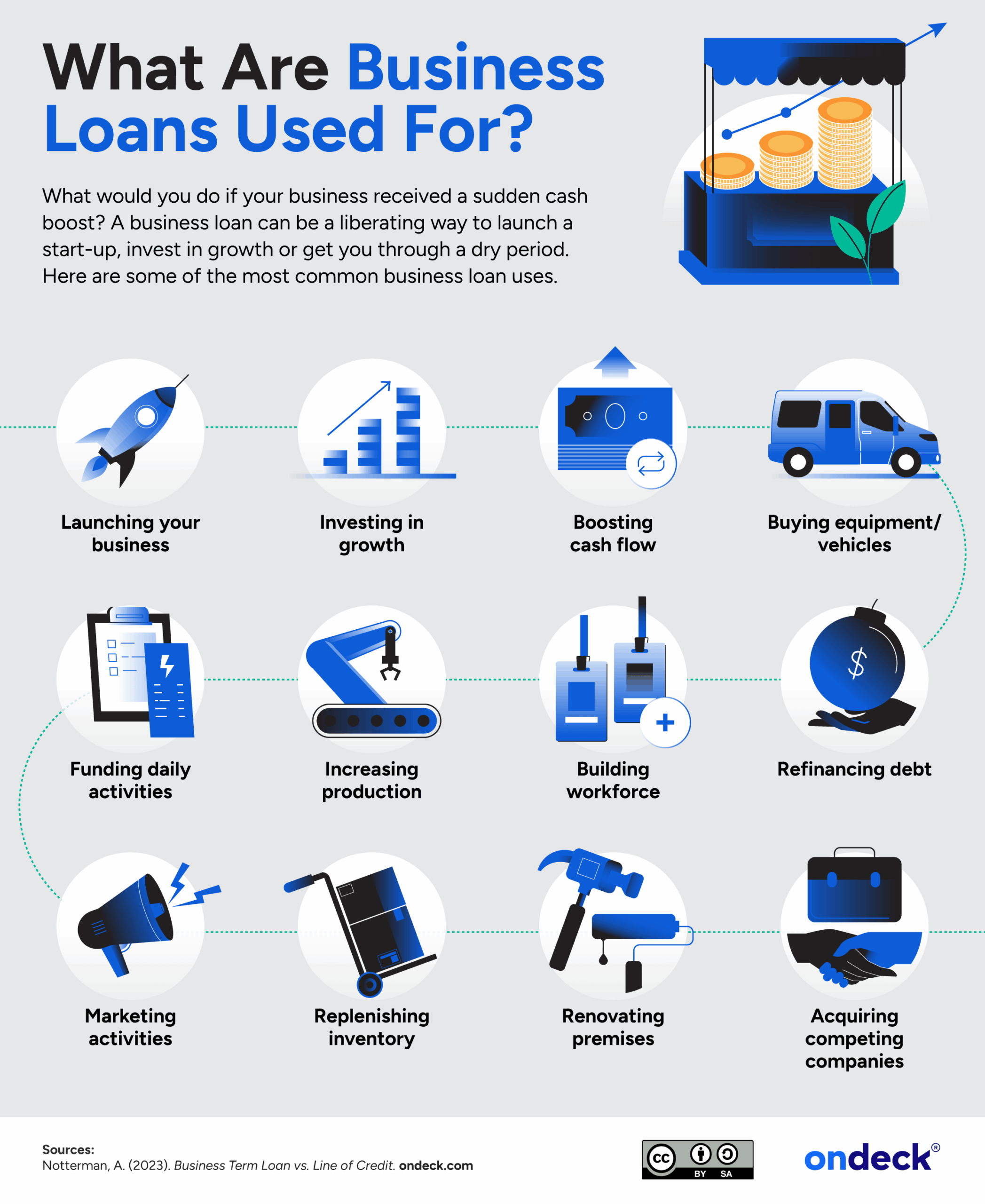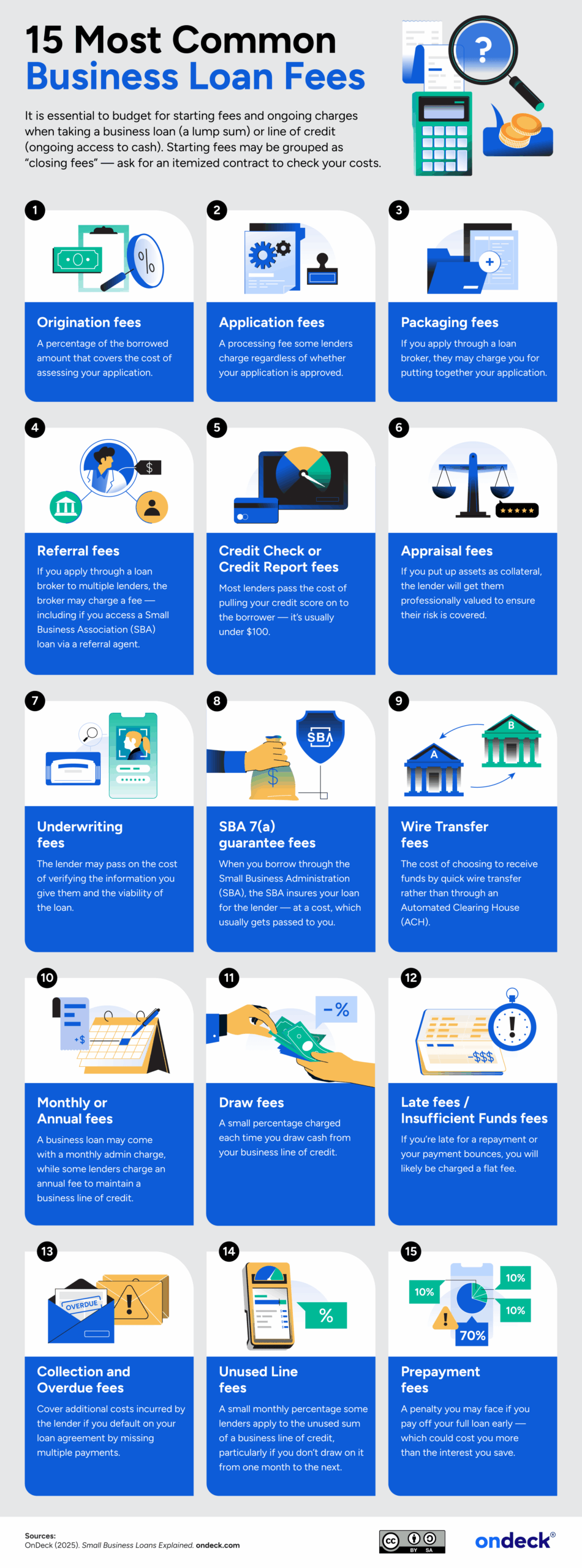Business Loan Calculator: Estimate Payments, Borrowing Costs and Loan Amounts
Business Loan Calculator
Disclaimer: The numbers entered into this calculator are for illustrative purposes only; this tool does not provide financial advice, nor does it guarantee specific outcomes.
How to use the business loan calculator.
Use our business loan calculator to estimate your payments and borrowing costs for a business term loan or line of credit. Just enter your loan amount, APR, desired term length and any applicable fees.
Definitions
| Term | Definition |
| Loan amount | This is the total amount of funds that you borrow. Because of deductions for fees such as origination fees, it may be more than the total amount of funds that you receive. |
| Interest Rate | A percentage of the outstanding loan amount that you pay to your lender for borrowing money. The interest rate is applied to the outstanding principal balance of the loan. Unlike APR, the interest rate does not incorporate fees or other finance charges. |
| Annual percentage rate | APR is the cost of your financing expressed as a yearly rate. APR includes the amount and timing of the funding you receive, interest and fees you pay and the payments you make. Your APR may be higher than your interest rate alone because APR incorporates interest costs and other finance charges. APR is not used to calculate your interest expense. |
| Origination fee | A percentage of the borrowed amount to cover the cost of assessing your application. This may be deducted at the time of disbursement. |
| Draw fee | A percentage of the amount advanced that can either be withheld from the advance, or it can be added to the total amount due. For purposes of this calculator, we have assumed that the draw fee will be withheld from the advance amount. |
| Term | The total period of your loan from disbursement to repayment, assuming you make minimum payments pursuant to the repayment schedule. |
| Payment frequency | This is the frequency at which you will repay your business loan. For purposes of this calculator, we have assumed that the payment frequency will not change during the course of the repayment of the loan, and that the payment will occur on the same day each week or month for weekly or monthly payments. |
| Payment amount | Your payment amount reflects the amount of daily, weekly, or monthly payments that you would make to your lender based on the inputs you provided to the calculator. |
| Total loan cost | The total dollar cost of financing. This amount represents the total amount of interest and fees that you would pay based on the figures you entered in the calculator. It does not include avoidable fees, such as late fees or insufficient fund fees. |
| Cost of capital | The total amount of interest that you would pay, based on the figures you entered in the calculator. It does not include any fees, only interest. |
| Cents on the dollar | The total amount of interest paid per dollar borrowed, based on the figures you entered in the calculator. Does not include fees. |
| Repayment amount | The full loan amount plus total interest expense. |
How do business loans work?
A business loan works much like other kinds of loans. The main difference is that the loan is obtained by a business owner and used for business purposes. Before applying for a business loan, the business owner determines the amount they need and researches lenders to find the best fit. Depending on the lender they choose, they might submit an application online or in person.
Typically, lenders will want to see your business’s financial statements and business plan. You may be able to secure your loan by providing some of your assets as collateral. If you don’t offer collateral, the lender may want a personal guarantee.
After submitting an application, the lender may offer you a lump sum term loan or a line of credit. If you accept, your business will need to repay according to their loan type and repayment schedule.

While the term loan and the business line of credit are the most prominent types of business loans, other categories and sub-categories cater to businesses with particular needs or circumstances. Here is a comprehensive look at the main types of business loans.
Term loan. A single lump sum generally repaid in fixed payments over a specified term — generally several months to several years.
Line of credit. A form of credit where a borrower receives funding up to a specified credit limit, from which they can draw as needed and only pay interest on the amount they use.
Merchant cash advance (MCA). A lump sum offered in exchange for a percentage of future sales — often taken from a business’s credit card sales.
Equipment loan. A term loan-style arrangement specifically for buying equipment. Generally, the new equipment is used as collateral.
Commercial real estate loan. A business loan secured by a mortgage on commercial real estate. It can come in the form of either a term loan or a secured line of credit.
Small Business Administration (SBA) loan. Typically, SBA loans refer to loans that are backed by the Small Business Administration. Because the SBA guarantees these loans, eligible borrowers often are able to get great rates and terms.
Working capital loan. A short-term loan to cover everyday costs. Typically, this type of loan may be taken during a quiet period, to be repaid by the time the company reaches its busy period.
Microloan. An unsecured loan of up to $50,000 (the average SBA microloan is $13,000). Microloans are often subsidized by federal or state grants, which can make them easier to get for businesses that might not typically be approved for a larger business loan.
Invoice financing. Invoice financing is less of a loan and more of an advance on unpaid invoices. You’re selling your unpaid invoices to a factoring company for less than full value, and the company keeps the full amount it collects on the invoices.
Start-up loan. These usually work on a similar basis to the term loan (above) but may have different features or rates targeting the needs and risks associated with new businesses.
As the variety of business loan types suggests, this form of financing can be a versatile solution for a variety of issues and opportunities that may arise at your company. Here’s a look at some of the uses you might find for the right kind of business loan.

Understanding business loan fees: what to expect.
Along with the interest you pay, you should be mindful of additional fees that some lenders apply to business loans. The main three fees can be summed up as:
Origination fees. These cover the cost of processing your application and may be charged at 2 – 5% of the borrowed sum.
Late payment fees. If you miss a scheduled repayment, you may be charged a fee; the amount of which will likely be disclosed in your loan contract. If you know you can’t make an upcoming payment, it is best to contact the lender in advance.
Prepayment penalty. Some lenders allow you to repay the loan early and qualify for interest forgiveness. However keep in mind some lenders may charge a fee if you pay off your loan ahead of schedule — because it deprives the lender of the interest they expected to accrue. OnDeck does not charge a fee for prepaying your loan , though some of the unpaid interest may still be due for prepayment of an OnDeck Term Loan.‡
These are just the most prominent fees. The infographic below outlines 15 common business loan fees. Be sure to check which ones your lender might charge before signing for a loan.

How to calculate how much of a loan you can afford.
There are two groups that you should be able to convince of your ability to afford any business loan for which you apply: the lender and yourself.
Loan underwriters work to ensure that a loan is affordable. They should not make a loan offer they feel your business cannot afford. They base this decision on the overall health of your business, any collateral you plan to use to secure the loan and your long-term business prospects. It is essential to be honest with the underwriter and yourself: can you comfortably afford the repayments a particular loan entails?
To figure this out, it is important to evaluate a loan not just on its interest rate but also on the overall payments that are due each month. Analyze your cash flow cycle and highlight the periods when cash is at its scarcest. Will you still be able to cover repayments?
Since your business is a dynamic entity, consider other cash flow demands that may arise during the repayment term. New projects, renovations or time off will all affect your ability to meet that monthly repayment. Consider also how much risk you are prepared to live with and how you will manage if your business hits an unexpected trouble patch.
Finally, look at the value of the loan: will it pay for itself in terms of the business opportunities it creates? If you have any concerns about your figures, seek advice from financial professionals before you make a decision.
How to choose the best business lender.
Taking a business loan can be the beginning of a long, high-value relationship. While it can be appealing to jump at a loan that offers an easy application process or other showy benefits, there are other factors to consider before choosing a lender.
1. Long-term relationship.
A business loan may bind you to a lender for anything from a few months to 25 years or more. Pay attention to how they deal with your early inquiries: do they respond promptly? Are they both personable and professional?
Look into the customer support systems they have in place for existing customers, and be confident you’ll be able to speak to somebody helpful when needed.
2. Reputation.
Always borrow with a licensed and regulated lender. Explore customer reviews on sites such as TrustPilot — not just for numerical ratings but for anecdotal evidence of what it’s like to be a particular lender’s customer. Look also into your local Consumer Protection Agency or private consumer watchdog like the Better Business Bureau, which maintains a list of accredited businesses.
3. Broker or lender?
While a broker may shop around for the best deal for you, they will charge an additional fee for using an intermediary. To maintain tighter control over your application and data, you might choose to go straight to the financial institution that is the source of the capital you’re borrowing.
4. Soft vs. hard inquiries.
When a potential lender accesses your credit file to assess your financial credibility, the process leaves a note on the file. If they make what’s known as a hard inquiry, it can also impact your credit score — one of the factors on which other lenders may make their offer. If you can, you may want to find a lender who will base the approval and terms of your loan on a soft credit check, which generally has minimal impact on your score.
5. Ability to refinance.
Refinancing during your loan term, by taking out a new loan to pay off the original, offers access to a lower interest rate or longer repayment schedule. This can ease the pressure on your payments and even free up more cash to invest in your business. Check what your potential lender offers by way of refinancing — the process may come with benefits like interest forgiveness and more capital but can also involve additional fees and credit score damage.
While it can be helpful to ask trusted colleagues in your network for recommendations, be aware that they may have accessed credit under very different circumstances from you.
Other common questions about business loans.
1. What is the difference between a line of credit and a term loan?
Business loans come in two main forms: a term loan or a business line of credit. Each has its pros and cons.
For a lump sum to cover major investments or projects with fixed costs, business owners can take a term loan and pay it back over time, along with the interest that accrues.
To cover short-term expenses or buy some breathing space during seasonal fluctuations, a business line of credit offers an ongoing source of cash (up to a fixed limit). In this case, you only pay interest on what you actually withdraw.

2. How do I calculate how much I can borrow with a business loan?
The size of the business loan that you’re approved for will depend on a number of different factors. These may include your business and personal credit profiles, as well as your ability to repay what you borrow. Collateral can also play a role in the size of the loan that a lender approves — the more collateral offered, the higher the loan amount may be. Etc.
3. How do I calculate the total interest cost?
The total cost of interest you are likely to pay over the term of your loan depends on whether you’ve agreed to pay simple or compound interest. Simple interest is applied only to the original loan sum. Compound interest includes this figure plus further interest on the interest your loan accrues as time passes.
To calculate the overall simple interest on a loan, multiply the loan sum by its annual rate and then by the loan term in years. For example, $125,000 x 0.06 (interest rate) x 5 years = $37,500. However, it is rare to be charged interest in this way.
For compound interest, it’s more complicated: the interest is considered not just against the initial loan sum, but against the changing balance of your loan as you make payments. This changing balance must allow for additional charges that the interest itself accrues – “interest on interest.”
First, you need to identify the following figures using the details of your loan agreement:
r: your interest rate divided by the number of times interest is charged each year.
N: total times the interest is compounded across the loan term (number of times per year multiplied by the number of years.)
P: Principal (initial loan sum).
M: Regular payment (usually monthly, weekly or daily).
To figure out monthly payments (M), apply this formula P [ r(1 + r)^N ] / [ (1 + r)^N – 1] = M
Using our example figures, assumingly monthly interest charges and repayments, the figure (r) is 0.005, and 12 months x five years gives (N) to be 60.
P [ 0.005(1 + 0.005)^60 ] / [ (1 + 0.005)^60 – 1].
Then, multiply your monthly payments (M) by total number of repayments (N) to give the total that you will pay across the full term. In our example, this returns total payments of $144,996.01.
To deduce the total amount of interest, subtract your loan sum from the total payments, e.g. $125,000-$144,996.01 = $19,996.01 interest.
4. Can business loans build business credit history?
A good business credit history makes it easier to get business funding in the future. Applying for a loan can negatively impact your credit score. However, if you choose a loan that reports to the business credit bureaus, you meet all your scheduled repayments and keep the utilization rate of your business line of credit low, you will demonstrate your reliability and this may be reflected in your business credit history over time.
5. Should I get a business loan?
A business loan can be an appealing prospect for an ambitious entrepreneur. But if you take one for the wrong reasons or the wrong type of loan, you could find yourself hindered by debts that restrict your future business plans.
The simplest rubric to follow is: if you don’t have a plan to increase revenue, don’t take a loan. Otherwise, even if you’re already struggling, you may find yourself in a worse position than you started. Neither will a lender be likely to approve your loan if they cannot see good business sense.
However, if you have an opportunity to expand your business or otherwise increase revenue, a business loan can be a great tool to make it happen.
DISCLAIMER: This content is for informational purposes only. OnDeck and its affiliates do not provide financial, legal, tax or accounting advice.



